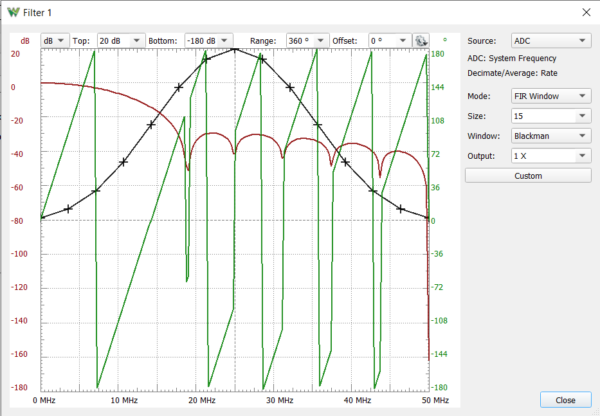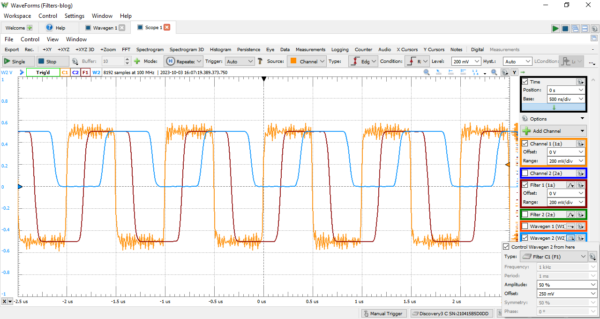Each day there’s more and more information coming at us from all outlets and it takes up valuable time and effort to determine what is worth listening to. People who can filter out all of the noise and simply focus what matters are the best kind of people to talk to as they are really tuned into what you are saying. Electronics, as you anticipated me to transition to, also benefit from the ability to be able to filter out any of the unwanted noise and glitches in the system, but like people, not every test and measurement device is able to do this on their own. Luckily for us, the Analog Discovery 3, Eclypse Z7, and the Analog Discovery Pro 3000 series devices are such products able to implement their own filtering. Let’s talk about it.
Filters can be implemented at a couple of different places in an Oscilloscope’s acquisition chain. Those that are further toward the user, at the end of the chain, are implemented in software and are generally more configurable. Filters that have been implemented using analog circuits designed into the device PCB can be used to modify a signal even before an on-board ADC ever converts it but are rather inflexible in their configuration. Digilent T&M devices are based around FPGA chips, which are particularly well suited to flexible digital signal processing, provide a third place to implement filters in between the analog circuit hardware and software filtering without affecting performance. This post will primarily focus on this third, more unique, filtering option.
FPGA-based filters get to perform operations on acquired data before it’s ever sent up to the WaveForms application on the host computer. These operations take advantage of highly parallel processing elements in the FPGA and allow data to begin being processed during the acquisition, potentially saving valuable processing time on the host computer. This parallel processing close to the ADCs and DACs also allows for forwarding of Scope input data to the AWG outputs through loopback paths in the FPGA, bypassing the host computer entirely. Latency between output and input is minimal since the data doesn’t have to be piped up to software through USB before being processed and sent back down. That said, purely software-based filters and other processing can be more flexible than FPGA-based processing, since it doesn’t rely on limited FPGA resources for implementation, and still has its place in every kind of measurement – this is why a distinction is made between software-based Math channels and FPGA-based Filter input channels in WaveForms.
The Analog Discovery 3 offers an on-board FIR filter for both analog input channels and the Analog Discovery Pro 3000 series devices with their larger Zynq chips have both FIR and IIR filters for all of their analog input channels. Both kinds of filters can be extensively customized, including setting custom parameters for FIR filters. These custom filters are made easier to design through the addition of the Filter Editor view, which can be used to preview what the frequency and phase response of your custom filter will be:

Figure 1: A built-in WaveForms preview of a low-pass FIR filter with an adjustable number of coefficients, cutoff frequency, and window type.
The previously mentioned loopback paths, newly available on many Analog Discovery devices (3000 series, Eclypse, and AD3), can be used with filters, so that your device can be used as an adjustable filter in an experiment, with the added ability to simultaneously capture data. This can be readily helpful if you need to output a clean signal based on the incoming noisy signal but require the output to be within a certain voltage range.

Figure 2: A noisy square wave is being received on the orange Scope 1 channel, filtering out the noise on the red Filter 1 channel, and then having the filtered data being offset and attenuated to the desired level on the light blue Wavegen 2 channel.
But sometimes you need more than one layer of filtering to reach the level of peace that you need. The Analog Discovery Pro 3000 series devices have a togglable 20 MHz low pass hardware input filter for each analog input channel to eliminate higher frequency components of incoming signals before they are ever received by the on-board Zynq device, and so are not configurable in any way.

Figure 3: Analog Discovery Pro 3000 series devices can have enable a 20 MHz low pass hardware filter for each analog input before it ever reaches the Zynq device.
Software filters, as you might expect, are performed by the WaveForms software running on the host computer. While the results of the software filtering cannot be used to trigger acquisitions in hardware, each of these mathematical filters can cascade from one another and perform more complex operations such as calculating the total amount of energy passing through a known resistor value between the two analog inputs or acting as a Lock-In Amplifier. Software filters can also be used to process and filter out unwanted frequencies from incoming signals, such as filtering out noise from the electrical grid that can be commonly observed on floating inputs.

Figure 4: A high pass filter implemented within the WaveForms software to eliminate the 60 Hz hum on the US electrical grid.
So there you have it; three filtering options that are available with Digilent Test and Measurement devices. Admittedly it will take quite a bit of work for them to be able to filter out traffic noise on your way to work so you can easily listen to music, but you can rest easy knowing that the analog input signals at your workstation are in good hands. Try it out for yourself with the latest WaveForms software, freely available within the WaveForms Resource Center here.
WaveForms 3.21.2 adds a couple other new features. Check out some more posts describing them, here: Scope to Digital – Interpreting Analog Input Signals as Digital Signals in WaveForms 3.21.2, Limiting the Scope of a Measurement with Extent for Measurements in WaveForms
For a full list of changes, check out the change log on our Reference site: WaveForms 3.21.2 Changelog.

